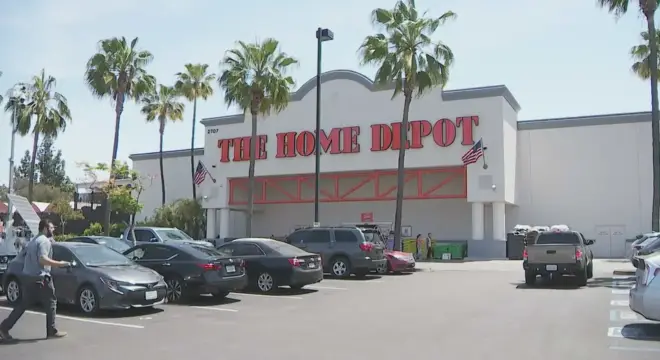CBP Raids Pomona Home Depot: Immigration Crackdown Provokes Backlash
Have you ever thought about what really happens when immigration enforcement steps into everyday life? What does it mean for workers just trying to do their jobs when federal agents suddenly show up? And how does the timing of a natural disaster, like massive firestorms, make the situation even more complicated?
Regarding post-2025 wildfires in January, U.S. Customs and Border Protection coordinated a significant raid at a Home Depot location in Pomona that resulted in 25 arrests –most were immigrant workers just trying to get their lives back on after the disaster.
It was not simply a common raid; it initiated major discussions in the community regarding the reasonableness and timing of targeting the most vulnerable individuals in a time of crisis.
Let’s dive into why this raid happened, why the timing matters, and what impact it had on the people caught in the middle.
2. The Raid
Details of the Raid: Date, Location, and Individuals Involved
On April 23, 2025, U.S. Customs and Border Protection (CBP) executed an unexpected operation in Pomona, California, at Home Depot. The operation was aimed at immigrant workers — specifically, at day laborers waiting for work outside the store following the catastrophic January firestorms.
Targeting Immigrant Workers
The focus of the sweep was day laborers, the majority of whom were undocumented immigrants. All of them wanted to make a living rebuilding their lives after natural disasters had ravaged their communities.
Arrests: Number and Nature of Charges
In all, 25 individuals were apprehended. Most of the individuals were charged not with a crime, but rather, an immigration-related violation. Many of these workers are simply trying to survive by working.
Confusion About Agencies Involved
There was initially a lot of confusion — many assumed that ICE was responsible for the raid. However, it turns out the operation was run by CBP, not ICE, which caused even more confusion and fear in the local community.
3. The Role of Immigrants in the Construction Industry
Immigrant Workforce: A Backbone of Southern California’s Construction Industry
Immigrants have long been a vital part of the construction workforce in Southern California. From rebuilding homes to repairing businesses, they fill critical labor gaps that many industries heavily rely on. Without their hard work and skills, many rebuilding efforts would stall or fall behind schedule.
Impact of the Firestorm: Demand and Consequences
After the catastrophic firestorms in January 2025, the demand for construction workers increased sharply since entire neighborhoods needed repairs or replacements. Immigrant workers helped fill this overwhelming demand.
By targeting these workers through raids such as was done at Home Depot, authorities may hinder further recovery efforts and increase the burden on communities trying to rebuild.

4. The Fallout
Community Reactions: Outrage and Fear
The raid immediately sparked outrage in immigrant communities and among labor rights advocates. In many people’s minds, it was a direct attack on vulnerable workers who were innocently trying to make ends meet in the wake of a recent disaster. Fear spread fast, as many day laborers felt they couldn’t go back to work because they might be the next targets.
Statements from Immigration Advocates: Strong Outrage
Several immigration advocacy groups, including CHIRLA, spoke out strongly against the raid. They characterized it as cruel and unnecessary and they stressed the impact of a raid on families who are already living in fear. Leadership emphasized that this kind of operation only served to increase fear and distrust of law enforcement agencies, not resolve it.
Human Impact: Real Stories Behind the Headlines
Personal accounts from workers who witnessed or experienced the raid were heartbreaking. Many feared deportation, separation from their children, or losing everything they had worked for. Some workers shared that they had survived the firestorms only to now face an entirely different kind of disaster — one that threatened their future in the U.S.
5. Political and Legal Context
Immigration Policies Under the Trump Administration: A Broader Strategy
The Pomona Home Depot raid is part of a larger schema of rigorous immigration enforcement activity that peaked during the Trump administration. In the 2010s, immigration enforcement left a range of options for authorities involved with us immigration, with a heavier emphasis on workplace raids for the purpose of purposefully disrupting undocumented workers and discouraging undocumented immigration overall. Although this incident involved CBP and not ICE, the incident demonstrated the administration’s vigorous actions directed toward undocumented labor.
Legal Ramifications: What Lies Ahead
For those arrested, the future is uncertain. Some may face deportation proceedings, while others might have a legal defense, depending on the circumstances. But the raid raises questions about the future of raids like this one. Immigrant rights groups are worried that the raid will help pave the way for additional raids – leaving immigrant communities more vulnerable to these types of raids all in the name of national security.
6. The Bigger Picture: AI and Technology’s Role in Targeting Immigrant Workers
Role of Technology in Modern Raids
Today’s immigration raids are not just about people but are also about technology. Federal agencies are often employing surveillance tools, data analytics, and now even artificial intelligence (AI) to surveil workplaces, individuals, and to organize events such as a raid on Home Depot, among many others. With direct access to employment databases, security camera footage, and digital communications, federal agencies are more capable of planning precise and targeted actions.
AI-Powered Tactics: A New Era of Enforcement
AI is transforming the situation in immigration enforcement again. AI tools enable authorities to analyze online activity and predict where undocumented workers might assemble to carry out one more effective raid. In some situations, authorities use facial recognition and predictive policing models to recognize and reproduce undocumented workers simply by combining patterns and data, which raises significant concerns about privacy, ethics, and misuse.
9. FAQ Section
What led to the Home Depot raid?
- The raid was part of a broader effort by U.S. Customs and Border Protection (CBP) to crack down on undocumented immigrant labor, especially after the increased demand for construction workers following the January 2025 firestorms.
How many people were arrested in the raid?
- According to reports, 27 individuals were arrested during the operation at the Pomona Home Depot.
Why were immigrants targeted during the raid?
- Immigrant workers, especially day laborers, were targeted because they make up a large part of the construction workforce in Southern California, and officials suspected that many were working without proper documentation.
How can this raid affect the local economy and construction industry?
- The raid could seriously disrupt rebuilding efforts after the firestorms by reducing the available labor force. Many construction projects rely heavily on immigrant workers, so losing them could lead to delays and higher costs.
What legal consequences could those arrested face?
- Those arrested could face deportation proceedings, possible detention in immigration facilities, and long-term bans from reentering the United States, depending on their individual immigration cases.
8. Conclusion
The Home Depot raid serves as a stark reminder of how deeply immigration crackdowns can traumatize communities and cripple sectors like construction. When you attack immigrant workers, it negatively affects families and reduces vital rebuilding opportunities for cities. Moving ahead, there is a need for more humane and fair immigration policies that recognize the contributions of immigrants to our economy. It’s time to advocate for smarter solutions that protect people while enhancing our future.
Read, watch, engage, and advocate for reforms that recognize the value of all workers.


